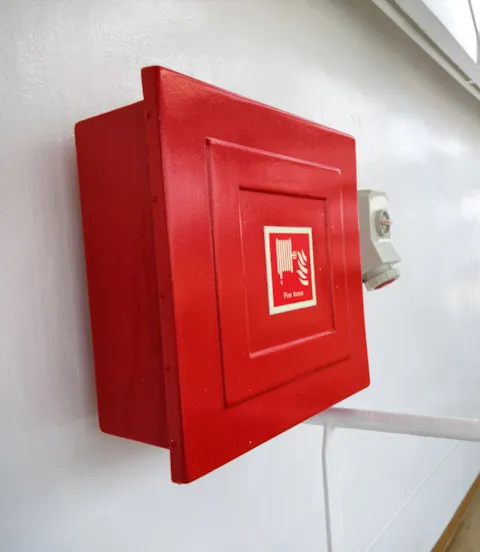Effective mitigation of fire risks on board
DNV GL has revised the voluntary F (A, M, C) class notation to account for findings from various fire incidents during the last decade and advancements in safety technology. The revised notations will be published in January 2018.
The last revision of the F (A, M, C) rules took place in 2005. That revision primarily focused on the F (M) engine room fire safety level. A recent evaluation of various fire incidents since 2005 revealed several trends, which have been taken into consideration for the latest revision:
Engine room fires are still rather frequent. In many cases they can be contained quickly by the new water mist systems, provided that the system is released quickly. In other cases the system was released with a delay, and in a few incidents not at all. Global statistics show several fatal accidents, in some instances with multiple fatalities.
Ro-ro fires have become a hot topic over the past ten years. The main area of concern are semi-open ro-ro decks on passenger ferries. On the other hand, closed ro-ro decks and weather decks show much better results.
Fortunately there have been few serious fires in accommodation spaces. Galleys are still a concern, and big laundries merit further close monitoring. There have been a few open-deck fires on cruise vessels involving plastic balconies, mooring decks and other areas where a fire can have a severe impact because of the proximity of crew and passenger cabins as well as public spaces. Design improvements in such areas are crucial.

Safety in focus
The F (A, M, C) is a voluntary class notation. Rules will only be applied if requested by the builder and included in the class contract between yard and DNV GL. With the revised class notation the class role shifts from confirming compliance with a given safety level to confirming that the safety provisions for a specified segment (“Accommodation”, “Machinery”, “Cargo”) not only comply with international regulations but also satisfy specific, relevant safety expectations.
Accommodation
New requirements for ventilation and smoke control in staircases and cabin/corridor areas have been defined for the F (A) class. Local alarms (buzzers) have been introduced for cabins. These new requirements will ensure rapid and safe evacuation in case of a fire in the accommodation area. As for galleys, the new version of the class notation contains a revised specification for shutting down deep fryers, and introduces a specification for the application of the F (A) class to passenger ships.
With these updates, DNV GL believes the additional watercarrying fire hose system requirement can be eliminated since the F (A) class specifies a sufficient number of portable extinguishers, fire hoses and lightweight firefighter outfits on board. The changes to the F (A) class are therefore cost-neutral.
Machinery
The updates focus on avoiding engine room fires by introducing oil leak prevention measures and ensuring that hot surfaces remain below critical temperatures and are oil-poof. These requirements are now covered by the basic F (M) class notation
Recent incidents have prompted DNV GL to add requirements for additional protection of engine room casings on passenger vessels, including suitable fire detection and water mist protection as well as control of the use of plastic pipes.
Cargo
Based on findings in its paper “Fires on Ro-Ro Decks” (2016P012, issued in April 2016) DNV GL has made amendments to the F (C) notation for ro-ro decks on cargo and passenger vessels.
The existing requirements remain in force (CCTV for ro-ro decks on ro-pax vessels, robust CO2 systems on cargo ships, extra and lightweight firefighter outfits, radios, etc.). The new requirements address the reliability and robustness of deluge systems protecting ro-ro decks. While SOLAS only requires manual release of section valves, the ability to release these valves remotely accelerates their activation. To reduce misunderstandings and failures, the section valves and remote-release installations must be marked, and general arrangement drawings posted.
A new policy for weather decks and open ro-ro decks as well as alternatively fuelled vehicles has been released.
On weather decks, water monitors must be installed which are accessible in case of a fire on a weather deck or ro-ro space. Open ro-ro decks are permitted but must be protected by steel roller shutters which can be closed when necessary. The revised rules also address survival craft, escape ways and ventilation systems with specific requirement on how these items and access to them are protected so that these essential safety systems are more likely to be available in case of fire on a ro-ro deck.
Additional requirements
In addition to the requirements of DNV GL’s F (A, M, C) class notation, Anders Tosseviken, Senior Principal Approval Engineer for Fire Safety & Life-Saving, DNV GL recommends to implement procedures and a policy for risk control. “Operators should define and revise their policies regarding acceptable operations and cargo on ro-ro decks. To ensure effective use of fixed fire extinguishing systems, operators should delegate the use of water-based systems to the lowest possible levels, define the release times, and conduct regular, realistic training,” says Tosseviken.

Anders Tosseviken
Senior Principal Approval Engineer